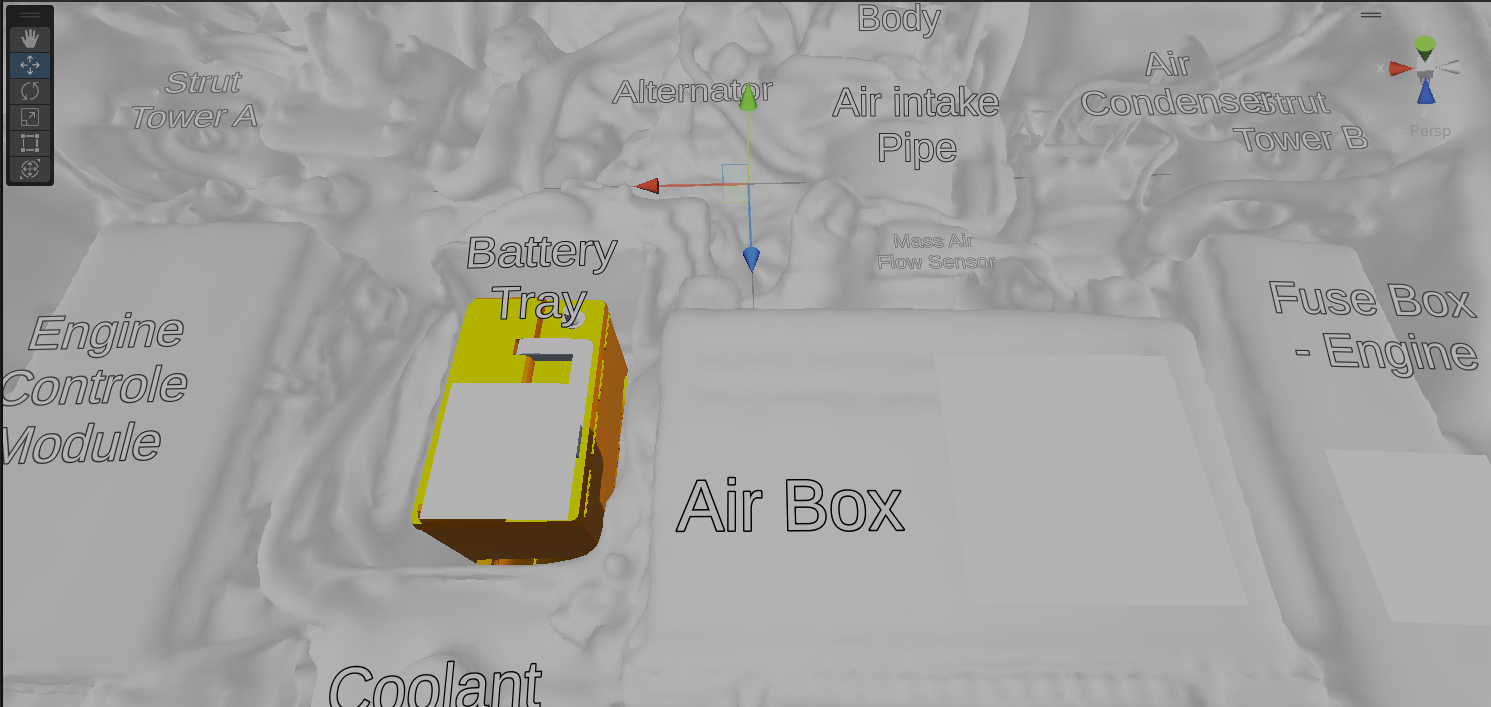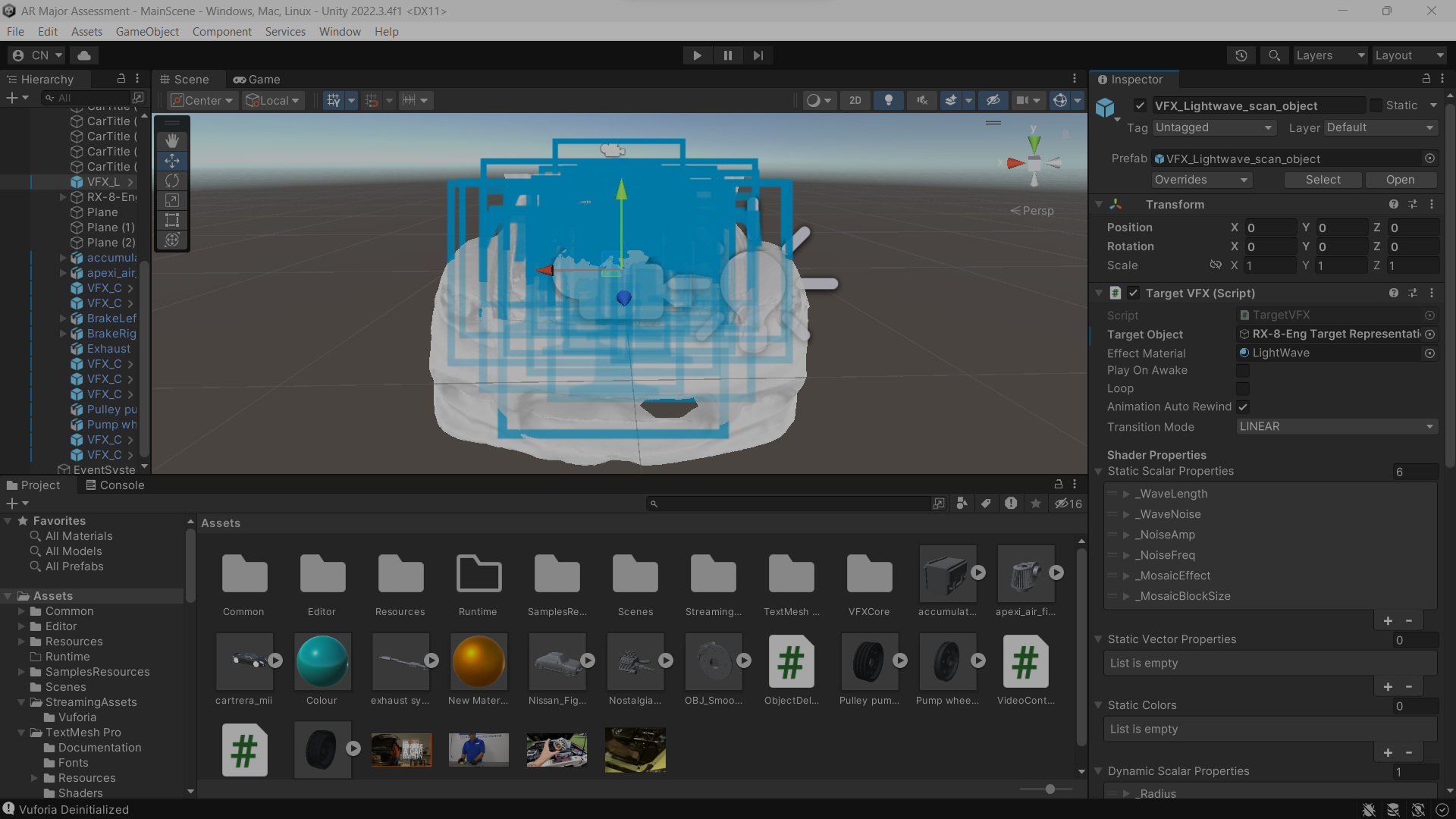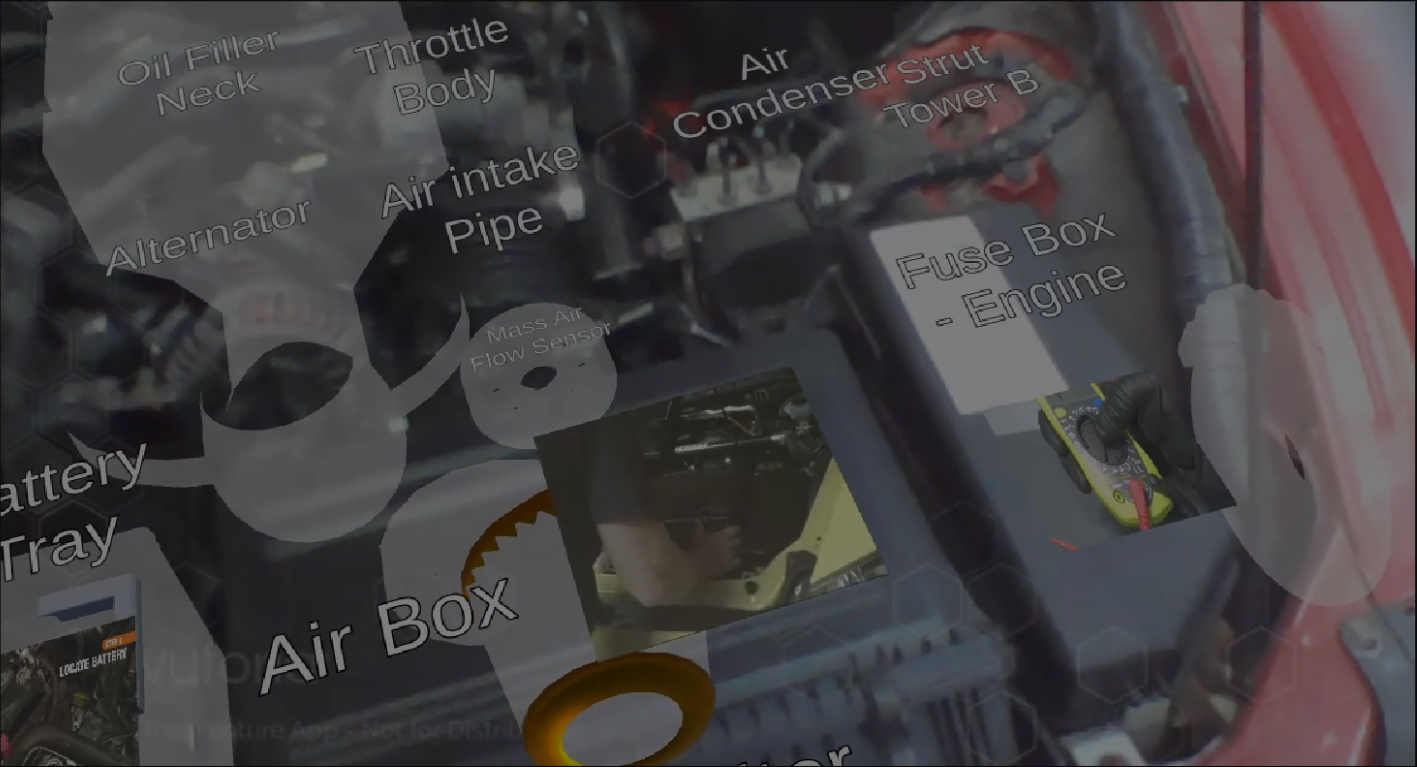Assessment 5 Report
Assignment 5: Unity Vuforia Model Target Development Report
Elevator Pitch: Do you ever feel helpless when your car malfunctions or needs servicing? Imagine having a reliable mechanic at your fingertips. Our augmented reality (AR) vehicle assistant is here to help. Use our AR app to instantly recognise auto parts, get interactive how-to guides, receive expert advice in plain language, stay safe with alerts, and decode your car's error messages. Join a thriving online community of both amateur and experienced mechanics. Our AR app makes even novice motorists confident in vehicle maintenance.

In the proposed revisions for the design following Assignment 4, a few design adjustments and adaptations have been implemented in the project. Originally, the intention was to solely depend on material that consisted of text and videos without the use of three-dimensional (3D) models. However, as a result of certain technological limitations and the aim to improve user satisfaction, the implementation of 3D models was undertaken. Furthermore, it should be noted that the initial design proposal incorporated a number of features that promoted user engagement, such as virtual buttons and text fade-in animations. However, it is important to recognise that the implementation of these elements was halted by the inherent limitations within the Unity Vuforia engine. The main emphasis was redirected towards Vuforia model targets and the utilisation of 3D models to enhance user engagement. Additionally, many aspects, such as safety measures and community support, were not incorporated into the project as a result of time limitations.

Technical Development:
The technological development of the project started by conducting thorough research and subsequently incorporating Vuforia model targets into the project. The Polycam programme was utilised to generate a three-dimensional scan of a Mazda RX-8, which was later uploaded to the Vuforia model target generator. The generator succeeded in creating a model that served as a target for automobile tracking. The technical development involved several key aspects:
1. Implementation of the Model Target: The model target was developed with the purpose of aiding automobile tracking. This enabled a comprehensive analysis of different components within the engine.
2. Component Identification: The identified components included the air box, oil filler neck, air intake, fuse box, battery tray, and other relevant components. Every component was visually identified and overlaid with corresponding labels.
3. Step-by-Step Guides: While the original intention of using virtual buttons was not possible, an alternative approach was used by using embedded video excerpts to provide guidance to users for doing different maintenance activities. The clips provided a comprehensive demonstration of doing particular tasks in a sequential manner.
4. 3D Models: The incorporation of 3D models of various automotive components, including the exhaust, brake rotors, callipers, battery, air filter, and pulleys, was implemented with the aim of enhancing user engagement and facilitating an even more immersive experience.
5. Vuforia VFX Animations: The implementation of sweeping animations from Vuforia VFX was intended to enhance the visual appeal of labels and 3D models while the automobile was registered and being tracked.
The technical development process involved adjusting to the constraints of the Unity Vuforia engine and investigating various approaches to design an augmented reality (AR) application that is both user-friendly and instructional.

3D Content:
The primary focus of the project's 3D material involves labelled automotive components and numerous 3D models representing components often found throughout a car's engine. The inclusion of 3D material enriches the user's experience by offering a heightened level of immersion and interactivity inside the environment. The primary components of 3D content include the following:
1. Labelled Automotive Components: These refer to the application of overlaid labels on various engine parts, resulting in providing clients with relevant details relating to each individual component.
2. 3D Models: Three-dimensional (3D) models are used to depict distinct vehicle components, including the exhaust system, braking rotors, callipers, batteries, air filters, and pulleys. The inclusion of a three-dimensional visual experience serves to enhance consumers' comprehension of the various components. The utilisation of three-dimensional (3D) material serves the purpose of educating users on the many components of an automobile's engine, hence enhancing their understanding of the maintenance of their vehicle.
Models Used:
TextMeshPro
Pulley A -

(3DRCreation (2018))
Pulley B -

(3DRCreation (2017))
Battery -

(veLuk (2015))
Air filter -

(DERSIN STUDIO (2019))
Exhaust -

(Domeen (2010))
Brakes -

(Strattus (2010))
Usability Testing:
The design and planning phases involved the implementation of usability testing in order to assess the user-friendliness of the application and the efficacy of its features. The procedure for testing involved the creation of scenarios where users were required to execute routine maintenance procedures on an automobile, following the provided sequential instructions, while engaging with the three-dimensional models and labelled components.
Recruitment: Due to limitations, the usability testing was carried out by a small group of participants, who happened to be the creator of the programme and his immediate family.
Testing Protocol: Participants were assigned specific activities, including oil changes and battery inspections, to complete. The participants' performance was assessed based on their ability to adhere to the consecutive instructions and engage with the programme in a productive manner.
Results: The conducted usability testing revealed that participants regarded the inclusion of labelled components and 3D models as beneficial in enhancing their comprehension of automotive components, but stated that the inclusion of the videos was most helpful. Nevertheless, the lack of functionality in utilising virtual buttons and the absence of text fade-in animations had a detrimental impact on the level of interaction and the overall quality of the user experience. Furthermore, it was observed that users expressed a desire for additional safety warnings and community support.
Findings: The analysis of the findings reveals that the application effectively facilitated the education of users on automotive components. However, its usability and interactivity were hindered by the absence of some features and limits.
In this section, we will discuss the outcomes of the usability testing conducted. In order to effectively address the outcomes of the usability assessment, a follow-up plan is made:
1. Enhanced Interactivity: Conduct a review of alternate approaches for enhancing interactivity, such as the exploration of Unity components or scripts that might serve as substitutes for absent virtual buttons, thus facilitating engaging interactions inside the programme.
2. Incorporation of User Feedback: Take into account the input obtained from usability testing and, if feasible, incorporate modifications that are consistent with user expectations. This may include the simplification of intricate tasks and the enhancement of user interfaces.
3. Safety Reminders: It is recommended to devise and execute supplementary safety reminders and precautions inside the application in order to ensure user safety when doing maintenance tasks.
4. Implementation of Community Support in the Future: As a potential improvement, it is suggested to provide a feature that enables users to actively participate in discussions, seek advice, and establish connections with similar car enthusiasts and experts.
5. Enhancing Visual Recognition Accuracy: Our ongoing objective is to further strengthen the precision of picture identification associated with auto components, thus increasing the application's capacity to effectively identify and label parts across diverse vehicle makes and models.
6. Expansion of Content: Enhance the existing database of automobile manufacturers and models, with the aim of enabling the application to accommodate a diverse array of cars and their distinct maintenance requirements.
The previously stated modifications and enhancements to the programme will effectively address the feedback obtained during the usability testing phase, hence improving the overall usability and efficacy of the augmented reality (AR) car maintenance helper application.
References -
1A Auto Repair (2019) How to Check For Bad Fuses With A Multimeter. YouTube. 10 September. Available at:
(Accessed: 24 October 2023).3DRCreation (2017) Free 3D pulley pump - turbosquid 1212977, Free 3D pulley pump - TurboSquid 1212977. Available at: https://www.turbosquid.com/3d-models/3d-pulley-pump-1212977 (Accessed: 26 October 2023).
3DRCreation (2018) Free 3D pulley pump model - turbosquid 1265061, Free 3D pulley pump model - TurboSquid 1265061. Available at: https://www.turbosquid.com/3d-models/3d-pulley-pump-model-1265061 (Accessed: 26 October 2023).
DERSIN STUDIO (2019) 3D conical air filter pack model - turbosquid 1445780, 3D conical air filter pack model - TurboSquid 1445780. Available at: https://www.turbosquid.com/3d-models/3d-conical-air-filter-pack-model-1445780 (Accessed: 26 October 2023).
Domeen (2010) Free exhaust 3D model, free exhaust 3d model. Available at: https://www.turbosquid.com/3d-models/free-exhaust-3d-model/544192 (Accessed: 26 October 2023).
heniadir (2006) Mazda RX8: how change air filter. YouTube. 29 October. Available at:
(Accessed: 24 October 2023).Strattus (2010) Free brake disk 3D model, free brake disk 3d model. Available at: https://www.turbosquid.com/3d-models/free-brake-disk-3d-model/523161 (Accessed: 26 October 2023).
veLuk (2015) Free max model battery car, free max model battery car. Available at: https://www.turbosquid.com/3d-models/free-max-model-battery-car/955030 (Accessed: 26 October 2023).
Vuforia (2020a) Introduction to model targets in Unity, Introduction to Model Targets in Unity | Vuforia Library. Available at: https://library.vuforia.com/model-targets/introduction-model-targets-unity (Accessed: 18 October 2023).
Vuforia (2020b) Model targets, Model Targets | Vuforia Library. Available at: https://library.vuforia.com/objects/model-targets (Accessed: 16 October 2023).
Vuforia (2020c) Optimizing model target tracking, Optimizing Model Target Tracking | Vuforia Library. Available at: https://library.vuforia.com/model-targets/optimizing-model-target-tracking (Accessed: 18 October 2023).
Vuforia (2022a) Advanced model target databases, Advanced Model Target Databases | Vuforia Library. Available at: https://library.vuforia.com/model-targets/advanced-model-target-databases (Accessed: 18 October 2023).
Vuforia (2022b) Model Target Generator User Guide, Model Target Generator User Guide | Vuforia Library. Available at: https://library.vuforia.com/objects/model-target-generator-user-guide (Accessed: 15 October 2023).
Vuforia (2022c) Vuforia Engine Tech Tip: Creating Model Targets with Polycam. YouTube. 3 March. Available at:
(Accessed: 27 October 2023).Vuforia (2022d) Vuforia VFX Library, Vuforia VFX Library | Vuforia Library. Available at: https://library.vuforia.com/unity-extension/vuforia-vfx-library (Accessed: 26 October 2023).
Leave a comment
Log in with itch.io to leave a comment.